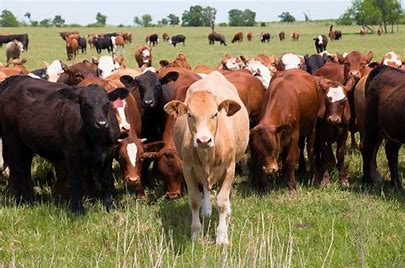

Sight
Cattle have a well-developed eye that sees some colour but not as much as humans. They generally avoid bright light if given preference.
The position of each eye allows very wide peripheral vision along the side. This alerts the cow to movement which is then investigated using binocular vision. A good side view is useful for watching where other animals are during grazing with head down. So cattle have nearly 360° vision as they move around when grazing.
Using two eyes, the cow has a much narrower binocular vision (about 25-50° ). Herdsmen exploit the wide peripheral vision when moving stock using their “point of balance” just behind the shoulder.
Cattle have a narrow blind spot at the rear where they are vulnerable, so they move a lot to keep checking it out. Cow’s eyes are designed to see down rather than up. When alarmed will raise head to investigate.
A bull in fight response uses one eye to watch you, but is getting his head ready for sideways swipe at same time.
Cattle can recognise different people from their shape and colour of clothing. They can also count, and associate more than one person or someone in green overalls, with pain or stress of injections or forced handling.
Hearing
Cattle are sensitive to high frequency sounds which people cannot hear. These high frequency sounds can increase arousal and low tones are more relaxing for them.
Music is regularly used in milking parlours to provide cows with a familiar background noise.
Smell
Cattle have a better sense of smell than people. The smell of blood can cause great panic. This is seen when cattle pass paddocks treated with blood and bone fertiliser. For some unknown reason, this panic is not consistent but is very real.
Touch
Cows have a very sensitive skin and can flick flies off from localised areas. Cows respond to touch and use it as an important form of communication among each other.
Mutual grooming is important in cattle, especially in mature animals. Dams lick and groom their calves right up to weaning. Touch is important for handlers to warn cows where you are – e.g. when milking. One really bad experience by cattle will put them off all people for a considerable time till a positive human/animal bond is restored.
 Contact Jaguza Support
Contact Jaguza Support